FOLLOWING the separation, Jean kept the Courbevoie workshop but, wishing to expand his business, he launched the construction of a new workshop at 59 bis, rue Denis Papin in Houilles in Paris region, behind the house he occupied since 1954. He just founded a new brand, Garen, a designation inspired by La Garenne-Colombes, a town where him and his family resided some years earlier.
The corporate name of the company became Stimer & Garen. Jean employed no more than two employees, including Basile Oliva. Hired in July 1959 as a cable fitter, he was promoted foreman at the beginning of 1963 and remained Jean's right-hand man for more than a decade.
The Micarmon, a pickup for harmonica, and the 6-watt Lima amplifier, the first company's model with printed circuit board and separate power supply, were the first Jean's creations since the separation. They were marketed from 1958.


Jean still offererd the previous models such as the M 10 and Nuance amplifiers before withdrawing them from his catalogue towards a new amplifiers family created in the very early 1960s : the Contrast, Clavier and Classic models. These devices profited from recent electronic improvements and allowed to produce special sound effects and timbres.
The first version of the Contrast model has the particularity of having a mono-button timbre changer. A second version enhanced with a vibrato was quickly supplied by the company around the year 1963.
More powerful, the Clavier (11 watts) and Clavier 25 (25 watts) amplifiers also are more complete. Each features a two-button tone controls as well as a vibrato and additional inputs. The French accordionist Aimable and guitarist Joseph Reinhardt, first Garen promoters, adopted the Clavier amplifier. In 1964, new versions delivered with reverb extended the Clavier series. « The one who gave me the idea was Johnny Hallyday. One day, he phoned me and timidly asked me if I had amplifiers with spring reverb. I didn't know that. It was at his earliest stages of his career. His first amps were Stimer ones... or Garen »
Characterized by a soberer presentation than the Contrast and Clavier, the Classic series originally consisted of two models : the Classic 11, the Classic 15 with or without a vibrato, with a power of 11 and 15 watts respectively. A fourth model with a capacity of 30 watts and particularly adapted for bass guitar, the Classic Basse, was introduced in 1962 and appeared at the time of its launch as the most powerful amplifier of the Garen catalogue.
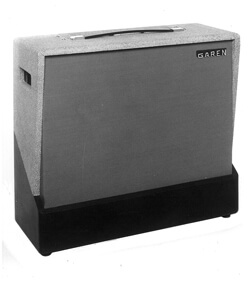
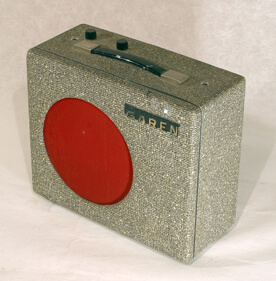
These amplifiers are fitted with French vacuum tubes of the Belvu, Mazda or La Radiotechnique brands. Jean also acquired American RCA and Tung-Sol tubes. Each valves were selected according to security and longevity criteria. The transformers used come from French manufacturers such as Vedovelli, Audax, Véga and Legrand. The loundspeakers of the first Garen models are French too : Véga, Audax, Gé-Go or Philips. « RV had an advantage over me. I'm stubborn sometimes, I didn't immediately twig it. He used good loundspeakers, Jensen ones. As for me, I used Véga or Audax models, which were of poorer quality. But I was cheaper than him. I've learned afterwards there were guys who bought me amps and put Jensen speakers in them. Yet I gave Jensen models to Audax engineers, so that they can duplicate them. I ordered about a hundred ones but it wasn't satisfactory. »
In order to retain customers, first Garen devices carried the combined designation Stimer and Garen, enabling his new brand to benefit from its predecessor recognition. On the amplifiers, the Stimer logo diminishes, indicating its abandonment.
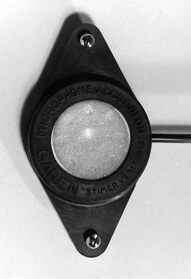
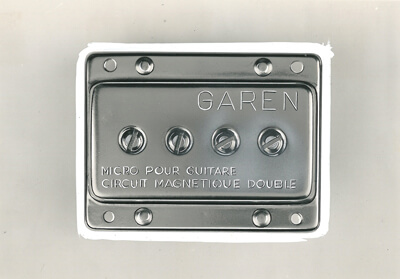
At this time, other amplifiers, pickups and sound equipment augmented the collection. The company also offered in its catalogue electric guitars fitted with Garen pickups as well as various accessories such as amplifiers covers, cables or jack connectors.
As in the time of the Guen brothers' association, the company manufactured and rented simultaneous translation systems used in international conferences.
JEAN transferred his business in the new Houilles premises around the end of 1960. The company was henceforth called Garen. The workshop comprises a spacious and well-lit assembly shop, an office, a warehouse as well as a room designed for trying out the equipment. The company entered in an industrial logic and was able to recruit more staff. Madelein Guen, Jean's sister, joined him as a handworker in February 1961 and then became his secretary. In october 1963, the company made its entry into the Commercial Register.
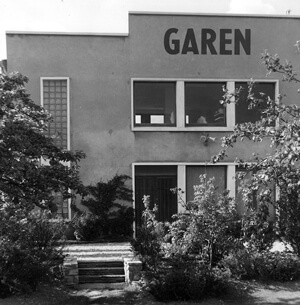
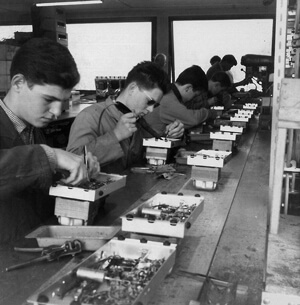
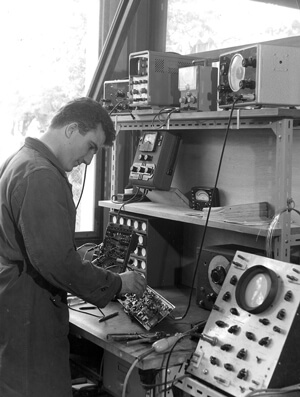
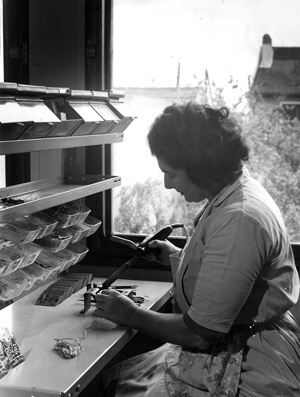
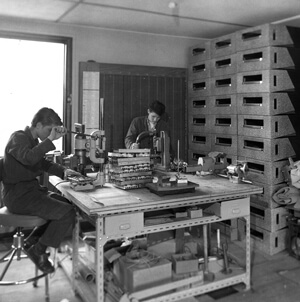
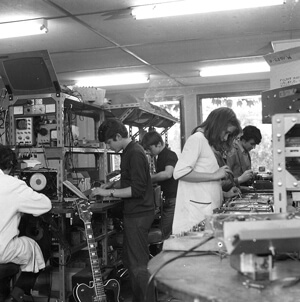
By the dawn of 1960s, the Garen company was booming. In 1963, it employed about twenty persons and had already produced numerous amplification items. Its products were sold in France and abroad by 1200 resellers. In the November 1963 issue of the Musique et Radio revue, a Garen advertisement proudly announced that 80% of the French guitar amplification market was manufactured by Garen and that 30% of its production was directed to exportation.
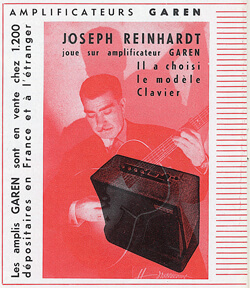
Despite prosperous beginnings, the Garen company quickly confronted a fierce competition which intensified over the decade. Foreign brands like Fender, Gibson and Ampeg from U.S.A., Vox, Marshall and Orange from England, Echolette from Germany or Farfisa and Binson from Italy gradually invaded the domestic market during the sixties. « When Fender arrived on the market, I saw my sales decline. I made money when no one else did. »
The French electric guitar market was itself more competitive than in the 1950s. Around 1963, Yves Guen, hitherto specialized in pickups manufacturing since the separation, decided to broaden his range of products making his own amplifiers. About the middle of the 1960s, Steve Brammer, father of the RV brand, created the Fender-inspired Stevens brand and Michel Benedetti developed under the Golden Sound brand a series of pickups for guitar as well as sound equipment.
IN a context of strong enthusiasm for American goods, symbols of prestige, Jean decided to create, like Steve Brammer with the Stevens brand, the Shade brand. Under this designation, the company developed a new range of amplifiers and sound equipment.
It was intended to suggest an American workmanship, regarded as commercially more favorable. All the indications on the control board are written in English and, in the manner of Marshall, the schematics are inspired by the Fender technology, a reference brand but too expensive for young persons.
Whereas since 1946, Jean had equipped his amplifiers only with loudspeakers made in France, especially with Véga, Audax, Gé-Go or even Philips models, the Shade amplifiers features the American Jensen speakers, just like Fender. However, the components used are mostly of French origin.
The Shade models display a more modern look than their contemporary Garen counterparts. Jean forsook the mottled greyish-white coating with bright red speaker grille, adopting a soberer covering made of imitation leather.
The first Shade amplifiers were baptized the Shade 25 and the Shade 40, with a power of 25 and 40 watts respectively. These two models, marketed from 1964, comprise two channels with two inputs each. The second channel is equipped with a vibrato and a reverb.
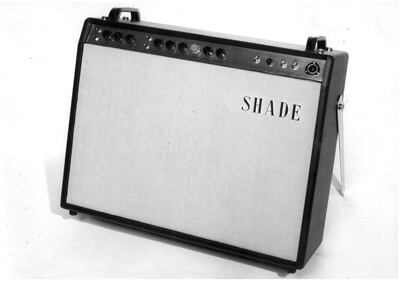
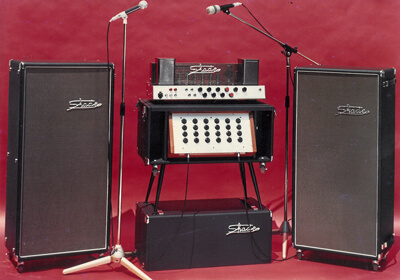
As regards sound system, Jean and his team built a preamplifier, the 63 R model, that features 6 inputs, each having four adjustment knobs for volume, treble, bass and reverb. This item was designed to be associated with two ultra-linear amplifiers, the 4240 RT and 4280 RT models, each generating 40 and 80 watts, They can be resorted to a maximum of 10 speakers.
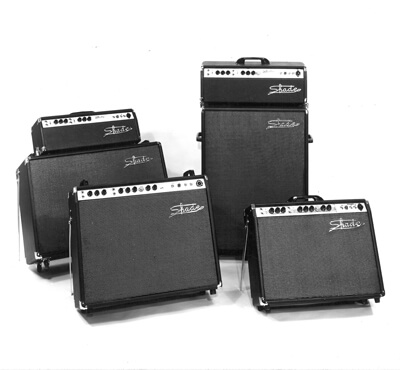
Around 1966, Shade products were renamed with U.S. states names. Furthermore, two new half-stack amplifiers were produced : the 40-watt Nevada model and the 60-watt Colorado model, initially intended to amplify bass guitars.
The Shade series met a sharp success both in France and abroad. Numerous stars and bands of that period employed Shade apparatuses. In the early 1967, musicians of the French band Guitars Unlimited utilized the 25-watt Ohio and 40-watt Dakota amplifiers while Maurice Larcange, a famous French accordionist, endorsed the Kansas sound system including the 4280 RT amplifier and the 63 R preamplifier.
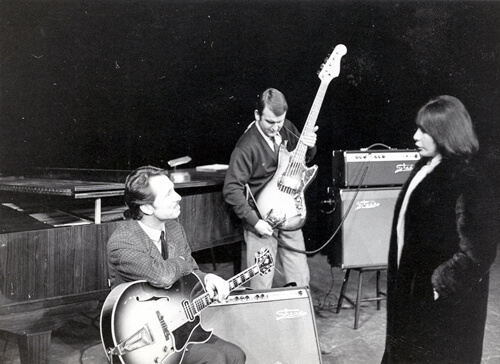
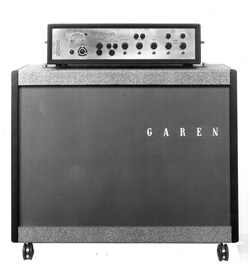
DURING the 1960s, the popularity of electric guitar and the music evolution resulted in a demand for still bigger and more powerful amplifiers.
From 1963, the Garen Tenor amplifier for bass and guitar, first half-stack of the Garen company, already reached 60 watts. At the end of the 1960s, the Soprano and Baryton amplifiers, respectively for guitar and bass, evolved from 40-watt combo models to 50-watt half-stacks then 100-watt stacks. In the same way, the Shade Nevada amplifier was modified with the mounting of larger diameter loudspeakers as well as the addition of two compression tweeters, and its power was increased to 100 watts. Jean, with a hint of irony, alludes to the success of these models with his new long-haired customers : « Musicians liked it, it was trendy. I remember one guy taller than me who went to buy me an amplifier. He told me : "Look, this one is amazing, we can hardly reach the controls ! [laughts] He was glad, it looked cool on stage. »
At the beginning of the 1970s, some Shade and Garen amplifiers delivered a capacity of 120 watts and incorporated distortion effects. « There was a sound that musicians liked : when it works at full power and makes "tzzzz", such as the humming noise of a bee. They called it "the sound". But you had to turn the volume up to high level. I therefore installed a circuit inside so as to get this bee sound, this special saturation which generates harmonics. It worked at low power. This was an asset. »
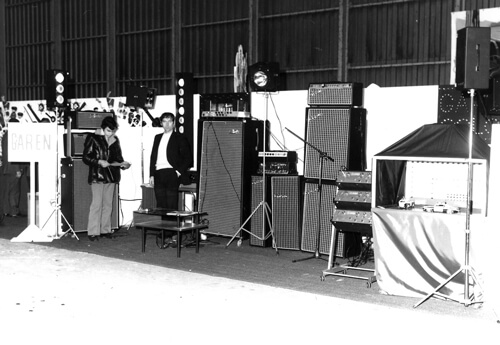
The 1960s also saw the appearance of independent effects units allowing to diversify the sound palette of the electric guitar.
Thus, in the early 1962, Jean built a 11-watt stereophonic reverberation chamber called Echo 11 and that allows to obtain a cathedral sound effect when the device is connected to an amplifier. His early research dates back to the Stimer era : « I starded making echo chambers with my brother. I became very interested because I wanted to make some for Edith Piaf. There was reverberation on his records, but not on stage. » Later, other reverberation systems were created.
The Garen distosion pedal was released in 1966. It has a three-positions harmonic switch. Three years later, Jean presented his Garen wah-wah pedal, allowing to produce wah-wah and distortions effects.
But the company offer was not limited to equipment for electric guitar. In 1967, two Garen electronic instruments were introduced : the Electronic Drums and the Electronic Gong. Incorporated in pedal, the former comprises a bass drum, a wood block and claves which are activated either with the foot with the help of a push buttons, or in an automatic manner with tempo setting. The latter consists of a ribbon microphone with four tiny metal rods allowing to produce a crystalline bell sound or glissando effects sounding like lap steel guitar.
Thereafter, stage lighting equipment were created and in particular, the Colorama, a selective spotlight of modulated light or the Stroboflash, an electronic lighting system for movements decomposition.
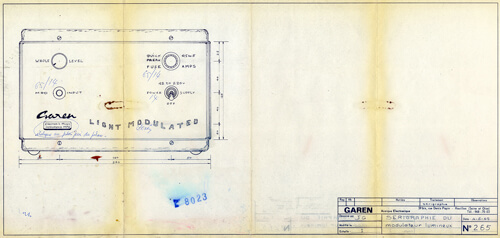
IN the early 1970s, the company was suffering. It employed less than ten people. Jean then decided to launch his two last brands : Shelton and Music Kit (MK).
Under the Shelton brand, Jean developed a new series of powerful devices including tube and transistor amplifiers for bass and guitar within a range of 90 to 120 watts, as well as sound systems. The Shelton models are equipped with Fane loundspeakers made in England.
The concept of the Music Kit brand intended to be economical and pedagogical. The Music Kit apparatuses, as the name suggests, were sold in spare parts and thus at a lower cost. It was up to customers to assemble himself the amplifier, with the possibility to receive assistance and advices from engineers.
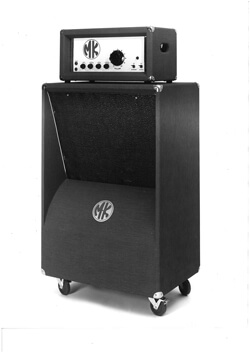
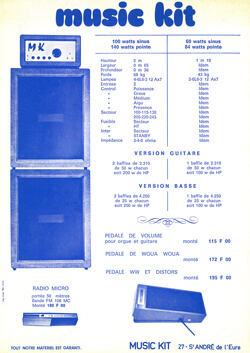
The idea yet came at a time when foreign competition was weakening the French production. These two brands encountered a limited success. « It became tough with the arrival of Italians, then Japanese around 1972. They made quite good and cheap stuff. I calculated, wholesalers bought them one amp much like mine at the price at which I purchased the components. But I was too sentimental towards my employees. I should have outsourced wiring to Italy, a good manager would have done it. [...] I made mistakes [...] I'm not a manager. I'm a technician, a dreamer. » Jean acknowledges. He gradually abandoned the amplifiers manufacturing and decided to focus his production on theft protection devices : central computer, motion detector, radar, siren, telephone dialer etc.
In August 1976, the Garen company was removed from the Commercial Register and was replaced by the Guelec firm, specialized in the construction and installation of anti-theft systems. The Guelec company also developed defense devices such as chemical sprays and other incapacitant weapons.
During the year 1980, the company decided to recentralize its activities in Paris. Close to his 60's, Jean refused to follow the Guelec company which proceeded to his dismissal. He retired in April 1981.
Jean Guen passed away on 13 December 2020, at almost the age of 99 years. He is buried at the Houilles Cemetery.